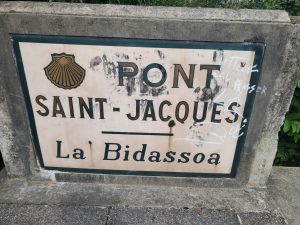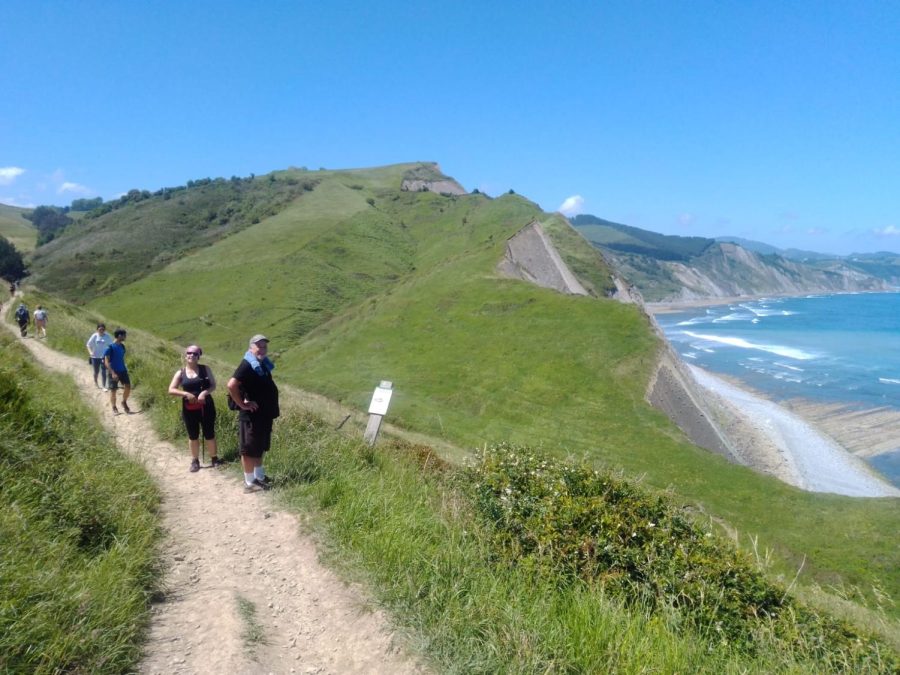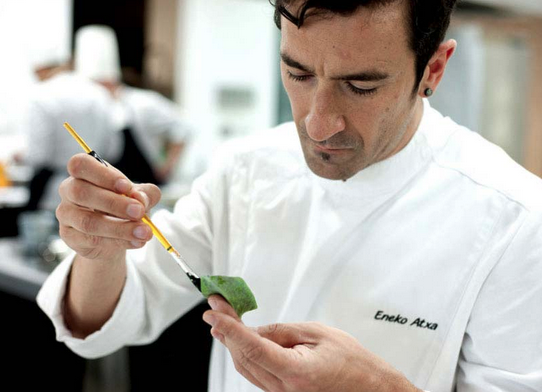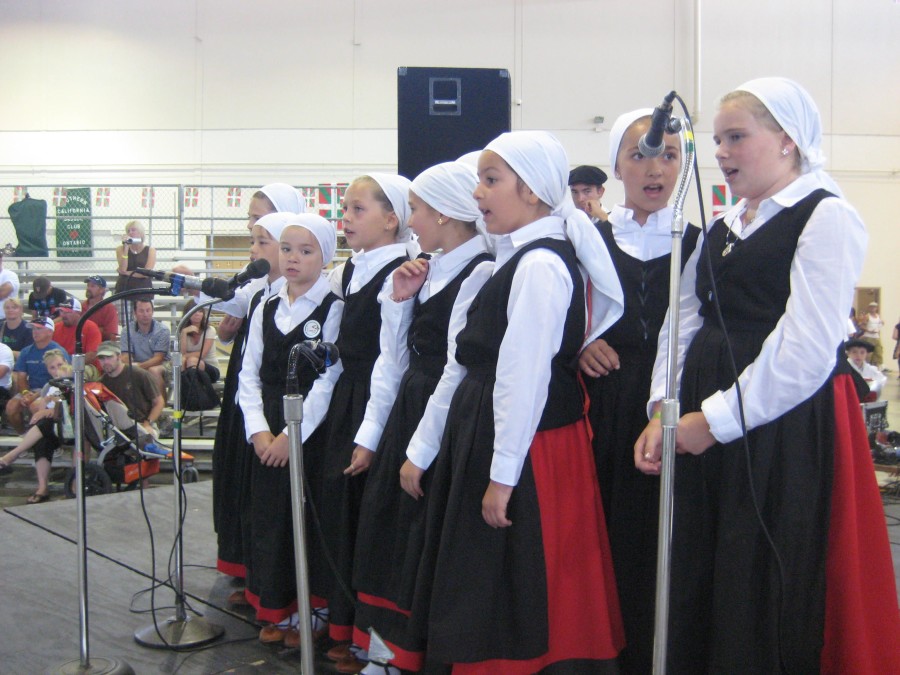As I write this, I’m enjoying a little down time in our apartment in Zarautz, Gipuzkoa, sitting at my computer with a view of the green hills and txakoli vineyards, with Basque accordionist Kepa Junkera playing on the Bluetooth speaker. A strong smell of coffee comes in from the kitchen where my son has set up his mini-roastery. Although born and raised in Southern California, I’m back in the town where I spent ten out of a total of 15 years of residency in the Basque Country, and where I hope to eventually live out my retirement.
Tomorrow I will be traveling to the town of Caminha in Portugal, to start a walk which I have wanted to take for some time and through a happy set of circumstances is finally coming to fruition. Many are already familiar with the Camino de Santiago, also known as the Way of St. James or in Basque, “Donejakue Bidea.” A number of acquaintances from the Chino Basque Club have done the “French Route” starting in Donibane Garazi (St-Jean-Pied-de-Port), and my brother and his wife took the “Camino del Norte” from Hendaia and across the Basque coast, through Cantabria and Asturias and onward to the pilgrims’ destination of Santiago de Compostela. Among my happy circumstances is having the Camino del Norte go right past our apartment in Zarautz.

Perhaps you’re wondering what else is going on in my life for me to consider myself such a lucky guy? I have the good fortune to work for Cisco Systems, a U.S. company consistently rated around the world as a top company to work for. Among our perks is the ability to take days where we might otherwise be working and put them towards volunteer work. Previously, I have put these days toward building houses with the Tijuana Mission Outreach Foundation, helping bring Internet connectivity to tribal lands through the MuralNet non-profit, and even the occasional tripota-making session at the Chino Basque Club!
This year, along with over 400 fellow Cisco employees, I’ll be putting those days to use to raise funds for a variety of worthy causes by walking the Camino Portugués from Caminha to Santiago de Compostela. While different groups of employees will be walking different routes over varying distances, in my case, I will spend seven days walking an average of 20 kilometers per day, for a total of 140 kilometers.
Living along the Camino del Norte has its perks. By walking the standard stages, I get in some physical training and gauge my preparation for what awaits on my actual walk.
The standard starting point is the Pont de St. Jacques, just across the border in the town of Hendaia (Hendaye). So on May 14, I caught a train across the border into France and started walking. My goal: start the day with a nice pintxo de tortilla, and then celebrate with pintxos and txakoli in Donostia (San Sebastian). And everything started out great!
The pintxo at the Café K2 in Irún had the right amount of runniness, and struck the right balance of proteins and carbs to get me through the day. The walk up the hill, past the Sanctuary of Our Lady of Guadalupe, through farm and pastureland with views of the Bay of Txingudi and the larger Bay of Biscay and the picturesque towns of Hondarribia and Hendaia, was beautiful.
When I got to the fork in the road, where I could choose the recommended flatter route versus the less-traveled “official” route, I was inspired to go for the latter. What could go wrong? It turns out, for a green pilgrim, plenty! The very steep trail didn’t seem to have that far of a climb, but in what turned out to be a recurring theme, each apparent crest in the trail, once reached, would reveal yet another crest to be overcome. All this was happening as temperature and humidity was approaching the 90s.

I don’t think that I’m exaggerating when I say that I set a personal record for sweating that day. My clothes were sopping wet, and the towel that I had brought seemed to have been dunked in a hot, funky, salty bathtub. To top things off, there are no sources of water anywhere beyond the sanctuary. If it were not for the generosity of a picnicking couple and an etxekoandre who refilled my water bottle as I got into Lezo, I would have come very close to be the next headline in the vein of “Idiot Hiker Suffers Heatstroke, Airlifted Off Jaizkibel.”
Over 2,000 feet of climb also means over 2000 feet of descent, so the way down was only slightly more relaxing, inflicting sore joints, twitching calves and quadriceps, and the occasional debilitating muscle cramps. Suffice it to say that I abandoned all hope of rewarding myself with pintxos in Donostia. I headed for the nearest train station and crawled back to Zarautz, tail between the legs.
I managed to return to finish that leg from Pasaia to Donostia, complete with the crossing, on a following day. The feeling of accomplishment is amazing. Breakfast of champions for that day was a tuna empanada, washed down with some local cider.
On May 22, I managed to tackle the Donostia-Zarautz stage, but in reverse. We were in for another day of tropical weather, and I didn’t want to miss out on the coolest part of the day sitting on a train. So I walked out my front door and climbed over the hill and through the txakoli vineyards to Orio, where I started the real climb to Igeldo after another tortilla breakfast of champions. I came better equipped water-wise, and although I still finished with thoroughly soaked clothing and towel, at least I never felt like my life was in danger.
My final training day was on May 29. I met up with my friends Joe and Iosune at her place in the Vista Alegre neighborhood in Zarautz, right next to the old Roman road that goes up the hill through yet more txakoli vineyards. Our target was the town of Deba, the end of the next stage on the Camino del Norte. I had a decent breakfast before leaving the house, which carried me over the hill to Zumaia, across the harbor by ferry, and up to the picnic grounds at Elorriaga.
Here we took a break in the tradition of the hamaiketako, the mid-morning snack, which for us was a chorizo sandwich chased down with a beer. This is another route where the traditional route takes you up to the clouds, while there are alternate routes that are a bit flatter. We opted for the traditional route through Itziar and the added exercise made the arrival in Deba all the more welcome.
Tomorrow I catch my plane to Portugal to start walking for real. At the end of our trip on June 10, some 400-plus Cisco employees will converge on Santiago de Compostela, all walking to raise money for various causes. To read more about the causes that I’m supporting, and to donate if you so choose, go to the Michael McCay Camino de Santiago Fundraising Page.















